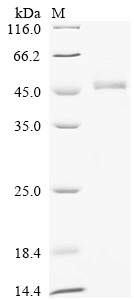The production process of the recombinant human O-phosphoseryl-tRNA (Sec) selenium transferase (SEPSECS) involves the expression of a vector construct in yeast cells. To create this construct, the gene fragment encoding the full-length human SEPSECS protein (1-501aa) is cloned with a C-terminal 6xHis-tag into a plasmid vector. The resulting vector construct, harboring the desired gene, is then transfected into yeast cells. Transfected yeast cells are carefully selected using specific antibiotics and subsequently cultured under optimal conditions. The induction reagents aid in the expression of the recombinant human SEPSECS protein within the yeast cells. After expression, the yeast cells are harvested and lysed to release their cellular contents, including the recombinant SEPSECS protein. Purification of the recombinant SEPSECS protein is conducted from the cell lysate, yielding a purity level exceeding 85% as confirmed by SDS-PAGE analysis.






